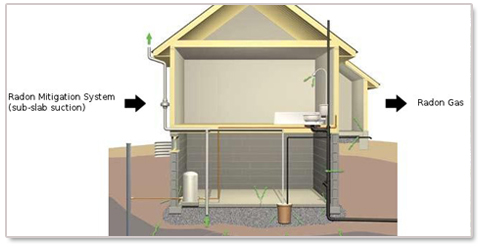Best Options for Radon Testing in Iowa
Radon levels in Iowa are dangerously high: research has found that five out of seven homes in Iowa contain an elevated level of radon. This naturally produced gas comes from the decay of uranium and radium in many different kinds of rocks. These rocks are located all over the state, making it common for radon to seep radon into the soil around your home. If the radon in this soil is allowed to enter your home through foundation cracks; exposed soil in the crawlspace; gaps and spaces between the walls, floor, doors, and windows; or through well water, it could pose a significant threat to the health of you and your family. Second only to smoking, radon is one of the most common causes of lung cancer. Do not take any chances. Have your home tested for radon immediately.

There are a couple of different ways to determine whether the levels of radon in your home are dangerously high. Radon levels above 4 pCi/L are considered dangerous, and steps should be taken to reduce radon if such a high concentration is found in your home. The best options for testing radon levels in your Iowa home are:
- Home Radon Testing Kits: These DIY radon test kits are an easy and inexpensive option that can be used if you want to see if radon is a problem in your home. The kits usually cost around $9 – $40. To use these kits, you need to ensure that all windows and doors are closed, and put the detector somewhere in your home where it can remain without disturbance for 48 to 96 hours. After following the directions with the kit, you will most likely have to send the detector to a lab an await results.
- Professional Short-Term Testing: Professional testing is a good option if you want more reliable results, or if you are going to be selling your home. This test usually takes around 2-7 days, but could remain in your home up to 90 days. Short-term tests use one of many radon detecting devices to monitor radon levels over a short period of time, giving you an idea of the average radon levels in your home. It is best to use a variety of testing methods to be sure about the results.
- Professional Long-Term Testing: Long-term testing methods use devices that stay in your home for over 90 days. Long-term tests are able to more accurately show you the average, year-round radon levels in your home. If you used a DIY radon kit, or had a short-term test done in your home and found elevated radon levels, consider following up with a long-term test.
While DIY radon kits can give you a good idea of the radon levels in your home, it is recommended to follow up and positive DIY tests with a professional radon test. Short-term test that show elevated radon levels should be followed by either a long-term test or another short-term test; if radon levels in your home are indicated to be significantly higher than the 4 pCi/L, have another short-term test done immediately to determine the best solution as soon as possible. If you are in the process of selling your home, it is especially important to have professional radon tests done, as the benefits of radon testing may help improve the appeal of your home.
What to do if Radon Exposure is High in Your Iowa Home
If the DIY tests show a high concentration of radon in your home, you should have a professional radon mitigation specialist visit the home right way. The team at Ameriserv is dedicated to removing dangerous radon from your home to ensure the safety of you and your family. We will help determine where the radon is entering the home and install a radon mitigation system that is customized to your home. Common radon mitigation techniques involve drilling a hole in the slab for radon to escape the home, and using fans and PVC ventilation systems to collect radon in the air and channel it out and away from the home.
Contact Ameriserv for more information today. We are happy to provide the residents of Iowa with our professional radon mitigation and testing services.

